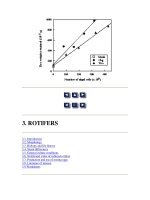Vietnam Fruit Production and Trade: The Opportunities and Challenges for Smallholders docx
Bạn đang xem bản rút gọn của tài liệu. Xem và tải ngay bản đầy đủ của tài liệu tại đây (4.16 MB, 19 trang )
Longan
Lychee
Mango
Banana
Avocado
Pummelo
Sweet orange
Mandarin
Mangosteen
Rambutan
Durian
Sweetsop
Soursop
Sapodilla
Grape
Papaya
Jackfruit
Langsat
Pineapple
Guava
Watermelon
Dragon fruit
Young coconut
Passionfruit
Plum
Lime
Star apple
Babados cherry
Vietnam Fruit
Production and
Trade: The
Opportunities
and Challenges
for
Smallholders
Nguyen Van Hoa,
Southern Fruit Res. Inst.
VIETNAM
DT (x1000 ha)
346.4
384.8
426.1
384.4
496.0
544.0
609.6
677.5
692.2
747.8
0
100
200
300
400
500
600
700
800
1995 1996 1997 1998 1999 2000 2001 2002 2003 2004
Graph 1: Vietnam fruit tree area during 1995-2004
(General statistic Department, MARD and Provincial
Agriculture Services)
Area (x1000ha)
Plan up to
2010
Earlier program
target
325023.1Western highland5.
386030.2Southern of Central
Coastal region
4.
807058.5Northern of Central
region
3.
1.000
380
150
230
90
90128.4South-East region6.
170178.4Northern highland2.
750767.1Total
250269.3M.D. region7.
6079.2Red River Delta1.
Area in the
year of 2005
LocationSNo.
1,000ha
Table 1: Fruit production area in Vietnam (Source: MARD 2007)
8 AGRICULTURAL PRODUCTION ZONES IN
VIETNAM
North East
Red River
Delta
Central
South
North West
(19%)
Central North
Central Highland
Mekong River
Delta (34.1%)
South East
(17%)
• There are 8 Agricultural production
areas in Vietnam
• The Mekong delta is producing a lot
of citrus, mango, longan, sapodila,
milk fruit (star apple ) , etc.
• The Southern East is a major
producer of durian, rambutan,
mangosteen, jackfruit, etc.
• The Central highland in the South
produces avocado, persimmon,
strawberry, etc.
• The Central of the South is major
producer area of dragon fruits,
mango, grape, etc.
• Up to HUE, the old Capital of
Vietnam, we grow tropical fruits.
• After HUE is sub –tropical condition,
we have sub- tropical fruits like
plum, peach, persimmon, litchi,
longan, citrus, etc.
26.425.02.02.0Grape
-133.3
13.5
8.5
Dragon fruit**
-146.020.2
Durian
472.7414.947.444.3
Pineapple*
380.9337.778.777.5Mango
379.6507.5113.7110.2Lychee,
Rambutan*
1,354.31,329.4103.4102.2Banana*
242.2209.330.428.6Pomelo *
606.4540.587.282.7Orange, lemon,
mandarin
628.8606.4120.3121.1Longan *
2005 20042005 2004
Production (x1000 tonne)Area (x1000 ha)
Fruit tree
Table 2: Area and production of major fruit trees in Vietnam 2004 and 2005
(Source: MARD 2006)
*Export fruit ** Number one fruit export
Table 4: Vietnam major fruits and
vegetables export value (VinaFruit-2005)
24,6040259,0822006
760,0002010
( plan)
35,00036235,0002005
142,80142329,9002001
120,35133196,582000
67,06836182,5542003
121,52942219,6982002
20,63839178,8002004
China (1000
USD)
Number of
country
Value (1000 USD)Year
* From 2003, there is a sharp reduction export to
China, as stronger competitions of fruits from
Thailand, Philippines, and Malaysia, etc.
Table 6: Fruit export markets, November 2006
(Vietnam Business news, 4th, Jan. 2007)
Singapore, BruneiSapodilla13
Netherlands, JapanAcerola12
Netherlands, CambodiaCustard-apple11
Netherlands, France, ChinaLychee (dried)10
Canada, Netherlands, China, CambodiaRambutan9
Latvia, Russia, ChinaBanana8
UK, Malaysia, US, France, Singapore, ChinaJackfruit (dried)7
Taiwan, Canada, Malaysia, USA, Japan, France, Singapore, ChinaOther fruits6
Taiwan, South Korea, Malaysia, ChinaCoconut meat5
South Korea, France, China.Longan4
Taiwan, Canada, Hong Kong, Kuwait, Liberia, Malaysia, US, Sweden,
Sudan.
Fruit jams3
Germany, UK, Poland, Belgium, Estonia, Netherlands, South Korea, Italia,
Mongolia, Malaysia, US, Norway, Russia, Japan, France, China.
Pineapple canned2
Thailand, Hong Kong, Taiwan, Netherlands, Singapore, China, France, UK,
Germany, Italia, Canada, Malaysia, Switzerland, Indonesia, Norway,
Saudi Arabia, Belgium
Dragon fruit1
Export Markets
Commodities
I. Potentials for development in
production and export:
1. Large number of varieties with good to premium quality fruits
in both tropical and subtropical fruits (deciduous fruits).
2. Conditions to increase in production area and yield are of
potential for Vietnam fruit industry
3. The increasing in export value of Vietnam fruit is of
potentiality which could increase in the coming time
4. The export volume of Vietnam fruits and its values are
increasing and are accessing a number of markets in the world.
5 . The Vietnamese in Vietnam and Vietnamese overseas prefer
to eat Vietnamese fruits, like mango, pomelo, star apple, etc.
6. The Government is considered fruits
II. Efforts taken to enhance the marketing
of tropical and sub-tropical fruits
EFFORTS TAKEN FOR DOMESTIC MARKETS:
-Implementing EUREPGAP standards for key
fruits like: dragon fruit, mango, longan, pomelo,
pineapple, lychee, etc.
Among them , dragon fruits got EUREPGAP Certificate in 2006
- VietGAP is developing, so that Certification is going to do
much more easy.
- GAP Cluster is developing since 2005, a join efforts among
farmers, traders, and local officers.
- METRO, Supermarket System in many countries, is helping
to improve Value chain in Vietnam which start first with pomelo
in the South.
II. Efforts taken to enhance the marketing
of tropical and sub-tropical fruits
EFFORTS TAKEN FOR DOMESTIC MARKETS:
- Implementing EUREPGAP standards for key fruits
like: dragon fruit, mango, longan, pomelo, pineapple,
lychee, etc.
Among them , dragon fruits got EUREPGAP
Certificate in 2006
- VietGAP is developing, so that Certification is going
to do much more easy.
- GAP Cluster is developing since 2005, a join efforts
among farmers, traders, and local officers.
- METRO, Supermarket System in many countries, is
helping to improve Value chain in Vietnam which
start first with pomelo in the South.
EFFORTS TAKEN FOR INTERNATIONAL
MARKETS:
- Implementing steps like for domestic markets,
- Try to Overcome Plant Quarantine Barriers
with US, Japan, Australia, New Zealand. SPS
Agreement with US and Japan are in processing.
- Some efforts in producing Organic fruits
started, first on Dragon Fruit
- We are having International Projects from US,
Japan, Australia, New Zealand, India, ADB, ect
to support our Fruit Industry improvement.
GLOBALGAP
For Producers
• 20 ha of Dragon Fruit got EUREPGAP Certificate
• Other 80 ha DF got GLOBALGAP Certificate
• One Packhouse going to get BRC Certificate
• 20 ha of Mango going to get GLOBALGAP on Feb, 2008
BRC For Packhouse
Manual for Dragon Fruit Quality
production
BOOKS WRITTEN FOR
GAP PRODUCTION
III. Supply chain mechanism
- Current apply in Supply Chain is a poor link between
the producers and the whole-sellers/ retailers.
- Most of the producers sell their fruits through the
collectors, the farm gate price is around haft of the
consumers price.
- Now with METRO SUPERMARKETS supports, a new
Supply Chain are seting up for vegetables, and fruits.
- AusAID , Autralia is conducting a project to improve
Supply Chain for Mango and Pomelo
- With these support, the farmers improving their fruit
quality to meet the demand of the buyers.
Challenges for fruit industry in VietNam
- The drawback is of small land holder and scatter in
which farm size is about 0.8 ha in Mekong Delta region
and 3 to 5 ha in East-South region
- No linking to each other between the farmers, hence,
the fruit volume and stable quality, price are problems.
- Packaging techniques and facilities are poor in
comparison with Thailand, etc.
- Export volume still lower than its capability and
potential
- Weak linking between traders and producers.
- Government policy still not clear
IV. Constraints in developing the markets for
fresh fruit produce
CONSTRAINS ….FOR LOCAL MARKETS:
- Strong competition from China (deciduous fruit), and
Thailand (mangosteen and longkong).
- Income of Vietnamese is still low in the region.
- Good quality Vietnamese fruit are selling very high price
in the local market, about 2 times higher than in Thailand,
good durian 1,5 US/kg, good mango 3 US/kg
-Stable quality and supply of local fruit are concerned by
the Supermarkets (as a result of no link among farmers)
-Poor packing, hence, high post harvest lost
CONSTRAINS ………FOR EXPORT MARKETS:
- Thailand, Malaysia, Philippines fruit industries, etc. have
developed long before Vietnam (we started from 1990’s). Hence,
Vietnam fruits facing strong competition from these countries
for the same kind of fruits in the International markets.
- Vietnam fruit industry is still at developing stage for quality,
safety, quantity to meet the demand of high value export
markets, and to fulfill EurepGAP and BRC standards (post
harvest standard).
- Vietnam has not signed SPS Agreement with many other
countries like Thailand had done.
- Air transportation cost to Europe is higher than Thailand.
- Export promotion activities are little as compared with that of
Thailand, etc.
V. How small farmers should react to the rapid
changing retailing sector and consumer
preferences:
- To join hand in production and marketing, by making
group for bigger volume, stable quality, and lower price.
- To produce Safety and Quality Fruit that meet the
VIETGAP/ GLOBALGAP standards
- To improve packing techniques, and invest in storage
facilities, to reduce post harvest lost.
- To create link, sign contracts with exporters,
supermarkets, wholesellers.









